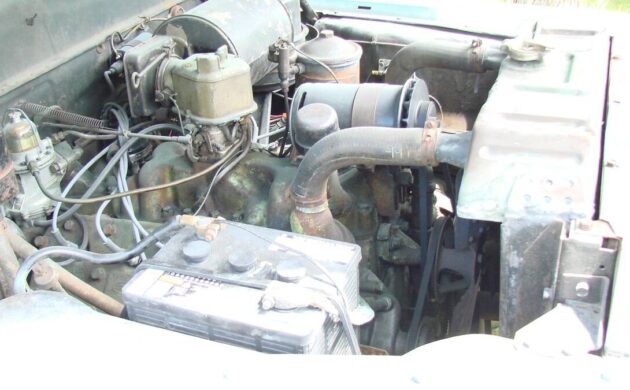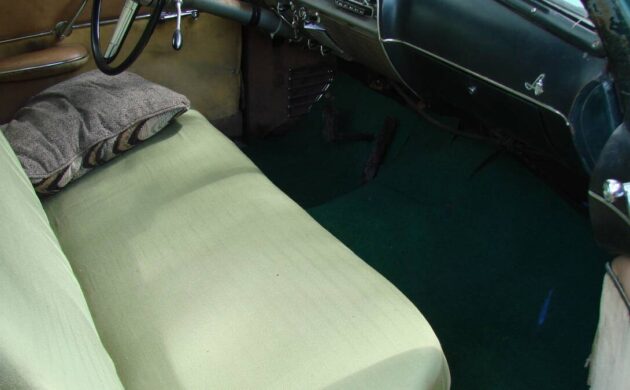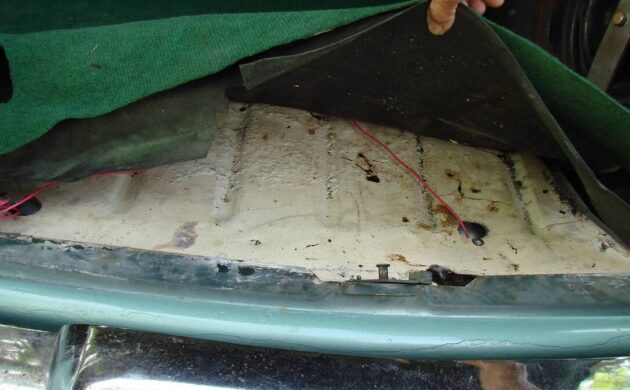Lincoln was always a name associated with luxury. But in the immediate post-war era, the division knew it had to make a move to regain market share from its formidable competitor, Cadillac. Next to the deep swoop of Cadillac’s design lines, looking very longitudinal indeed, the Lincoln was stodgy. Lincoln’s update came in 1949 when it introduced the Mercury-based “Baby Lincoln” and its more upscale cousin, the Cosmopolitan. Together these were known as the EL series. The Baby Lincoln rested on a 121-inch wheelbase, and it featured recessed headlights and integrated fender styling. Its long side trim emphasized the length of the car. However, it still used a two-piece windshield, and it looked suspiciously like a Mercury. Here on craigslist is a 1951 Lincoln Sport Sedan for sale, with an asking price of $7,000, located in Whitehall, New York. We have Rocco B. to thank for this tip!
The EL Lincolns were originally slated for a bespoke V12 engine but instead, all 1951 Lincolns were fitted with Ford’s 337 cu. in. flathead V8 making about 152 bhp. This engine was an improved version of the same 337 used in earlier cars. Consumers had complained about its oil consumption and vibration; these issues were addressed by the time 1951 rolled around. The Baby Lincoln has an automatic transmission. The seller indicates that this car runs well, and it has several new parts including the gas tank and sending unit. The brakes and generator were rebuilt too.
The interior is the weak point of this car. The headliner looks like it’s had a poor application of the Pink Panther insulation found in your attic. One door panel is missing; the other is moldy. But hey, that’s the fun of a project, and at least interior work is not as expensive or invasive as rust repair can be. And the car does have suicide doors!
Speaking of rust repair, the seller indicates that the frame is free of rust (hope so!), and the front floors have been replaced. The trunk and back seat panels are clean. The front end of the 1951 model gathered some criticism. Its grille arrangement departed from the earlier clean horizontal stretch across the front end. Instead, it featured a ‘center square’ look that really wasn’t elegant at all. These cars did not bounce Cadillac from its first-place berth at the time, and today, values are suppressed. Still, the design – especially around the greenhouse – has aged well. The color is great, nicely set off with those white walls. I think tackling this car would be very rewarding for a new collector, and the entry price seems right. What do you think?






Now is when you ask did Lincoln use a Mercury body or was it the other way around?
Looks like finally a sensable price for a good start of a collectable car! Runs and drives, needs some upholstery work and general clean and shine. A family guy could enjoy and park at a cars and coffee open those doors and I am sure they will come, lol.
Believe me , they will come! There’s a local enthusiast who owns the ’50 sibling to this one except he’s is black. It draws massive attention at every show or parade, which is quite interesting to observe for a mostly unrestored well-kept 4door only…! 😏
As for the automatic; does this one use GM’s Hydramatic…?Anyone…?
Hi local sheriff. Yes, Lincoln did use the GM Hydramatic from 1949 to 54.
From 1949 through 1954, all Lincolns used GM’s HydraMatic transmission. It worked well and got the job done for Lincoln. There were two different body shells used. The smaller or “Baby Lincoln” use the Mercury body, which was smaller than the larger series, the Lincoln Cosmopolitan. The “Baby” used the split windshield and the larger Cosmo used a one-piece windshield. Both models are fine cars and undervalued in the marketplace. They are excellent highway cruisers and have comfortable interiors. I own a 51 dark blue Cosmo, first owned by Jack Warner of Warners Brothers.
Thanks Bob, any intel on whether the unit installed in Lincoln was IDENTICAL to the GM unit as goes for bellhousing, mounts and internally? I know there were Hydramatics installed in other than GM cars – it’s just that I find it odd that GM would share the advantage of offering the – at least in its era – most usable auto transmission
Nash, Rambler, Hudsons, to name a few.
local_sheriff,
The original 4-speed Hydramatic was built by a separate Hydramatic division of GM with the idea they could be sold for many different uses, not just in cars. There were even a few gas & diesel inter-urban railcars with the Hydramatic. This is one of the reasons the main cast iron case didn’t have a bell housing, and the tail shaft was quite short.
But from 1940 to 1948, You cold only buy a GM *car* equipped with a Hydramatic. Since it was clear that other companies like Borg-Warner and Packard were coming out with their own automatic transmissions [not to forget about Buick and Chevy], the company decided to offer it to outside buyers too.
During WW2 thousands of 2.5 ton US Army trucks were built with the Hydramatic. One of the reasons it was installed in those trucks was because it was easier to teach the typical GI to drive a big truck with an automatic transmission than to spend the additional training time teaching them how to drive a vehicle with 4 gears and a low/high transfer case. Plus because the original Hydramatic was so over-built and reliable, there was less down time due to drive line damages from misuse.
I can certainly see why these did not bounce Cadillac off their first-place berth at the time.
A couple days after writing this up, I discovered one living in my town. It was stopped so I could look at it. Really lovely in person! Not as large as I expected, and wonderful lines.
Michelle
Every time I read a barn find write up and I’m impressed by the author I look it up and see your name. I enjoy barn finds. I’m not car a fanatic with encyclopedic knowledge like some of the followers but I know superior writing when I see it. You have a talent. Thank you for using it to bless lives like mine.
What headliner?
I have a 1950 Studebaker Starlight Coupe that I recently had the interior redone, including the headliner. I was more than pleased with the results and the headliner looked better than many new cars I’ve had. I chose a great automotive trim shop with great references, and he was about 25% lower priced than the more expensive shops.
While I agree with all of the comments, if you look closely at things (under the hood, door jambs and edges that they didn’t bother to paint) you’ll find that it was originally dark green or at least once was and probably has a cheap paint job thrown on it, covering who knows what (there’s rust showing in the jambs). Also, the condition of the interior and the pretty serious looking rust on the seat frame is concerning and may be an indication of what the rest of the car once looked like. I’d REALLY like to see the undercarriage. It’s hard to say from tree shadows, but is there a crease in the driver’s side front door, coming out from the inside?
I live in NY where the elements are not kind to cars. This definitely needs a careful close inspection in person of every nook. If it is solid, it could be a great deal, but I have my suspicions. Either way, it’s a lovely looking car.
The 47 Studes took the postwar auto hungry world by surprise. The big 3 still had their stodgy fat gendered standbys.
After the 47 Champion/commander models were completed, The Loewy design team was laid off. Looking for jobs one of the team landed an opportunity to design and present.
He lengthened the design he knew, lowered the belt line and even incorporated a ‘bullet’ into the grille.
Take a look and you will see a studebaker under every Ford,Lincoln Mercury of that era.
The big 3 still didn’t get it in 53
Studebaker always had a penchant for shooting themselves in the foot. Good styling didn’t mean sales.
Always admired the factory Frenched/tunneled headlights on these, a very sleek and distinctive look.
I had a beautiful dark blue, 16,000 mile example like this car, but 100% original. in 1979 I was taking it and 2 other cars to a car show, and a friend was driving the Lincoln when he forgot to stop at a stop sign and totaled it. Ran into the back of a pickup truck, and the truck rode over the Lincoln’s front bumper, pushing everything back, it was not possible to open either front door, and the radiator was wrapped around the engine.